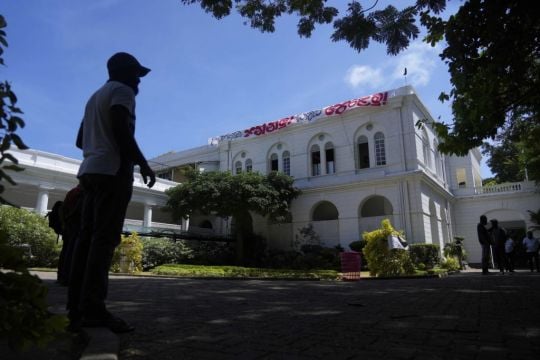Protesters have retreated from government buildings in Sri Lanka, restoring a tenuous calm to the economically crippled country, as the embattled president at last emailed the resignation that demonstrators have sought for months.
President Gotabaya Rajapaksa fled a day earlier under pressure from the protesters enraged by the island nation’s economic collapse.
He finally emailed his resignation a day later than promised, according to an official.
But the crisis was far from over because he has further angered the crowds by making his prime minister, Ranil Wickremesinghe, the acting leader.

Protesters have pressed for both men to leave and for a unity government to address the economic calamity that has triggered widespread shortages of food, fuel and other necessities.
But with a fractured opposition and confusion over who was in charge, a solution seemed no closer following Mr Rajapaksa’s departure.
Mr Rajapaksa and his wife fled Sri Lanka early on Wednesday aboard an air force plane as protesters were taking over government buildings to demand he resign.
On Thursday, he went to Singapore, according to the city-state’s Foreign Ministry.
It said he had not requested asylum.
Mr Rajapaksa promised over the weekend he would do so, but instead he named his prime minister acting president in his absence.
Meanwhile on Thursday, the government announced a curfew in the capital Colombo and its suburbs to run until 5am on Friday and protesters were withdrawing from the presidential palace after occupying it during the weekend.
Some were seen unrolling a red carpet in the palace as they left.
Anticipating more protests after a group attempted to storm the parliament’s entrance a day earlier, troops in green military uniforms and camouflage vests arrived by armoured personnel carriers on Thursday to reinforce barricades around the building.
Some protesters had posted videos on social media pleading with others not to storm the parliament, fearing an escalation of violence.

Protest leader Devinda Kodagode told the Associated Press they were vacating official buildings after the parliament speaker said he was seeking legal options to consider since Mr Rajapaksa left without submitting his resignation letter as promised.
The protesters accuse the president and his powerful political family of siphoning money from government coffers for years and Mr Rajapaksa’s administration of hastening the country’s collapse by mismanaging the economy.
The family has denied the corruption allegations, but Mr Rajapaksa acknowledged some of his policies contributed to the meltdown.
A flight believed to be carrying Mr Rajapaksa landed in Singapore on Thursday.
It was not immediately clear if that was his final destination.
A Maldives official initially indicated he planned to travel onward to Saudi Arabia, but later could only confirm his first stop in Singapore.
Since Sri Lankan presidents are protected from arrest while in power it is likely Mr Rajapaksa planned his departure while he still had constitutional immunity and access to a military jet.
On Wednesday, protesters undeterred by multiple rounds of tear gas scaled the walls to enter the office of Mr Wickremesinghe as the crowd outside cheered in support and tossed water bottles to them.
Protesters took turns posing at the prime minister’s desk or stood on a rooftop terrace waving the Sri Lankan flag.

Amid the mounting chaos, Mr Wickremesinghe’s office imposed a state of emergency giving broader powers to the military and police.
Defence leaders have called for calm and co-operation with security forces – comments that have rankled some legislators who insist civilian leaders would be the ones to find a solution.
The protesters blame the Rajapaksas for leading the country into an economic abyss, but they are also furious with Mr Wickremesinghe.
They believe he has protected the president and that his appointment in May alleviated pressure on Mr Rajapaksa to resign.
Mr Wickremesinghe has also said he will resign, but not until a new government is in place.
He has urged the speaker of parliament to find a new prime minister agreeable to both the ruling and opposition parties.
It is unclear when that might happen since the opposition is deeply fractured.
But assuming that Mr Rajapaksa resigns as promised, Sri Lankan legislators have agreed to elect a new president on July 20 who will serve the remainder of Mr Rajapaksa’s term, which ends in 2024.

That person could potentially appoint a new prime minister, who would then have to be approved by parliament.
The political impasse threatens to worsen the bankrupt nation’s economic collapse since the absence of an alternative government could delay a hoped-for bailout from the International Monetary Fund.
In the meantime, the country is relying on aid from India and China.
The shortages of basic necessities have sown despair among Sri Lanka’s 22 million people.
The country’s rapid decline was all the more shocking because, before the recent crisis, the economy had been expanding, with a growing, comfortable middle class.
“Gotabaya resigning is one problem solved – but there are so many more,” said Bhasura Wickremesinghe, a 24-year-old student of maritime electrical engineering, who is not related to the prime minister.
He complained that Sri Lankan politics have been dominated for years by “old politicians” who all need to go.
“Politics needs to be treated like a job – you need to have qualifications that get you hired, not because of what your last name is,” he said, referring to the Rajapaksa family.
After the president fled to the Maldives the whereabouts of other Rajapaksa family members who had served in the government were unclear.







